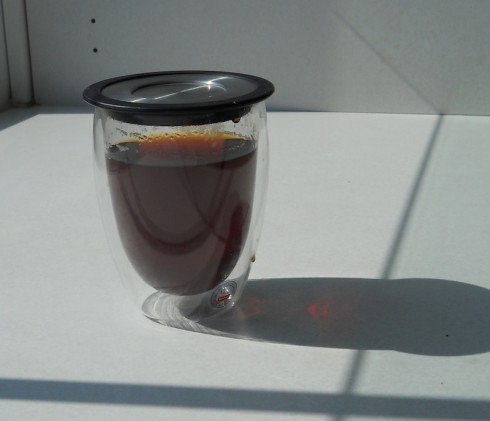It’s a glass really. Double walled, liquid suspended in air, beautiful to look at. But it really becomes a wondrous artifact of engineering when its combined with the heavy, rubber and stainless steel lid. The beauty and thermal efficacy of this tea-making system is … elegant. It’s certainly a worthy starting point for our discussion of heat, temperature and thermodynamics in general, and generates interesting questions about heat transport (convective, evaporative, conductive and radiative) and the greenhouse effect, that can be tested with relatively simple experiments.
The first, and most obvious thing my students observed was the fact that the lid prevented heat escaping. The weight of the lid confines the head space, which reduces convective heat loss above the cup and increases the vapor pressure, which reduces the amount of tea that evaporates. Evaporation is the primary way heat is lost from hot liquids, since each gram that evaporates takes 540 calories of heat with it. A simple evaporative heat loss experiment showed that about 70% of the cooling of a cup of water came from evaporation.
The second thing the students pointed out is that the double walled glass insulates, because it reduces conductive heat loss. Solid glass has a thermal conductivity of about 0.24 cal/(s.m.K) (Engineering Toolbox.com; 1 J = 0.24 calories). The conductivity of the air in the space between the walls is two orders of magnitude less at 0.0057 cal/(s.m.K). Of course, having a vacuum in the space would be even better, but it would test the strength of the glass.
Thermally, the glass falls short when it comes to radiative heat loss. A silvery coating would reflect radiated heat back into the cup much better than transparent glass. However, silica glass is relatively opaque to infra-red, which should reduce radiated heat emission. A simple experiment, comparing the cooling rates of water a glass flask wrapped in aluminum foil to one without the foil should give some indication if radiative heat loss is significant.
Finally, the glass does have a thermal advantage though, via the greenhouse effect. Because it is transparent to short, high-energy wavelengths of light, like that of sunlight, but blocks the longer wavelengths of heat energy, the glass should be able to capture some heat from sunlight. This can also be experimentally tested with a couple flasks in the sun. It would be interesting to find out how any greenhouse warming compares to the radiative heat loss through the glass walls.
Last week my students did some basic observations and came up with their own experiments. Then they learned a little about thermodyamics from reading the textbook. This week, we’ll try to get a little more quantitative with the experiments and applications of what they know, and it should be interesting to see if what they’ve learned has changed the way they observe the common objects around them.
